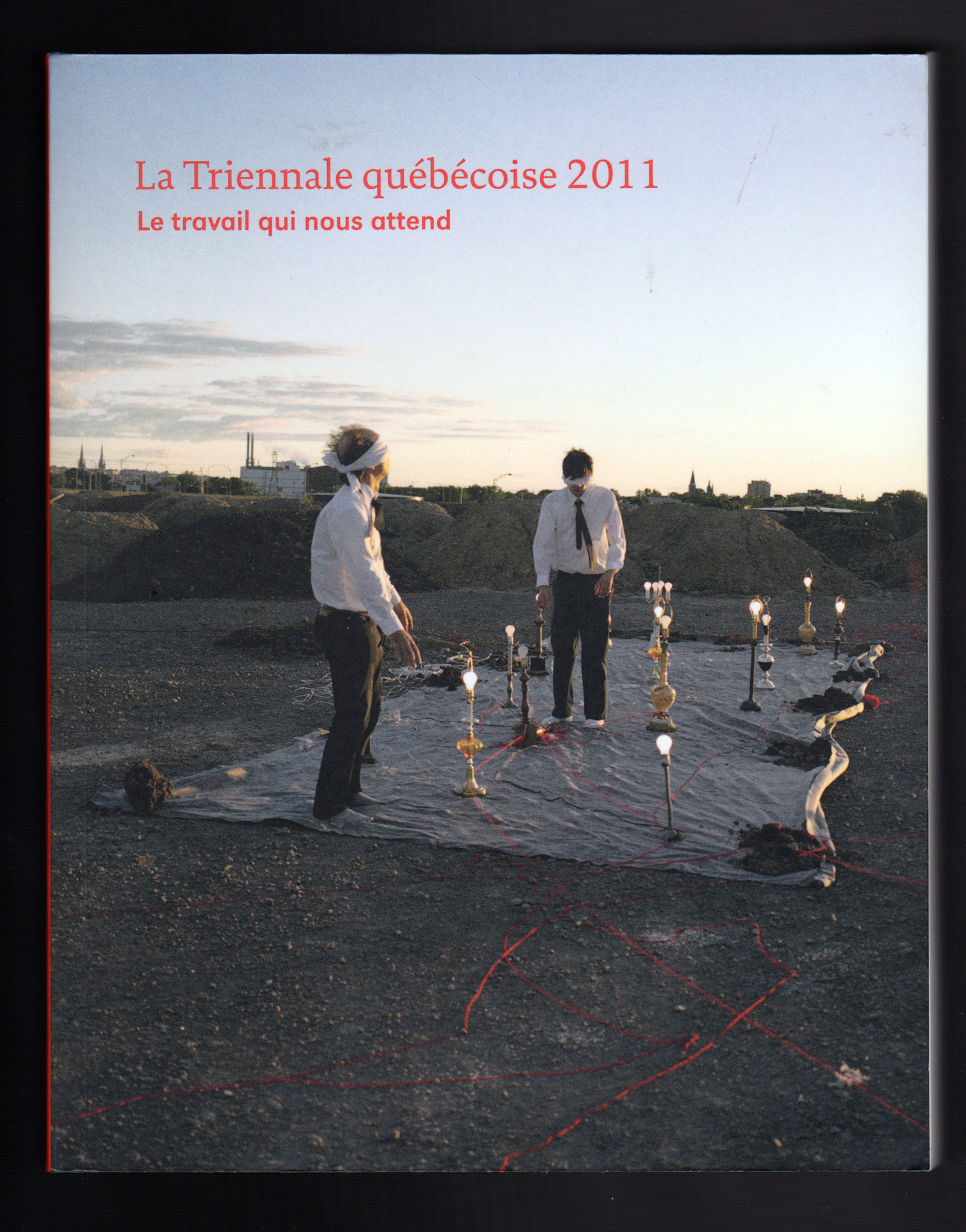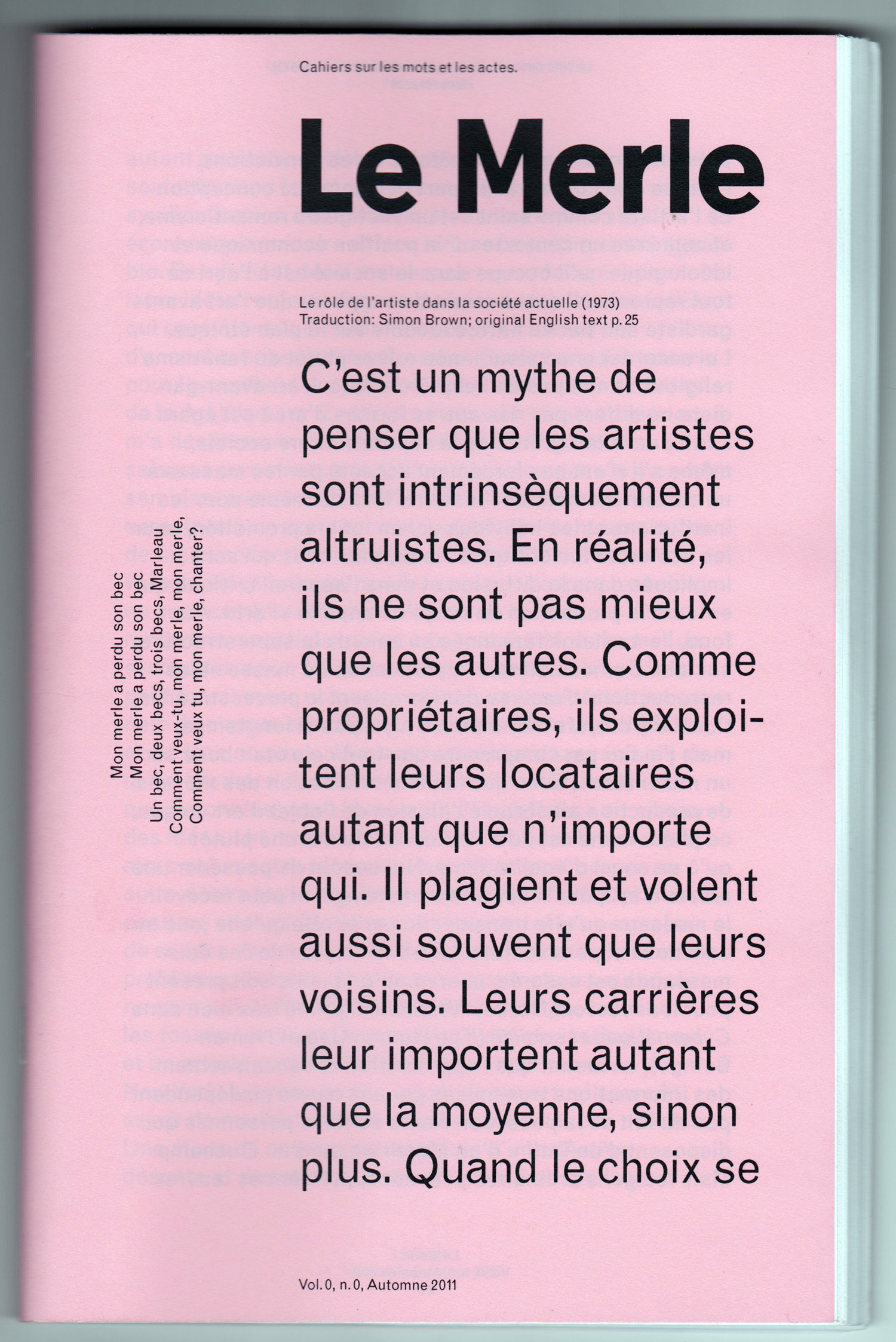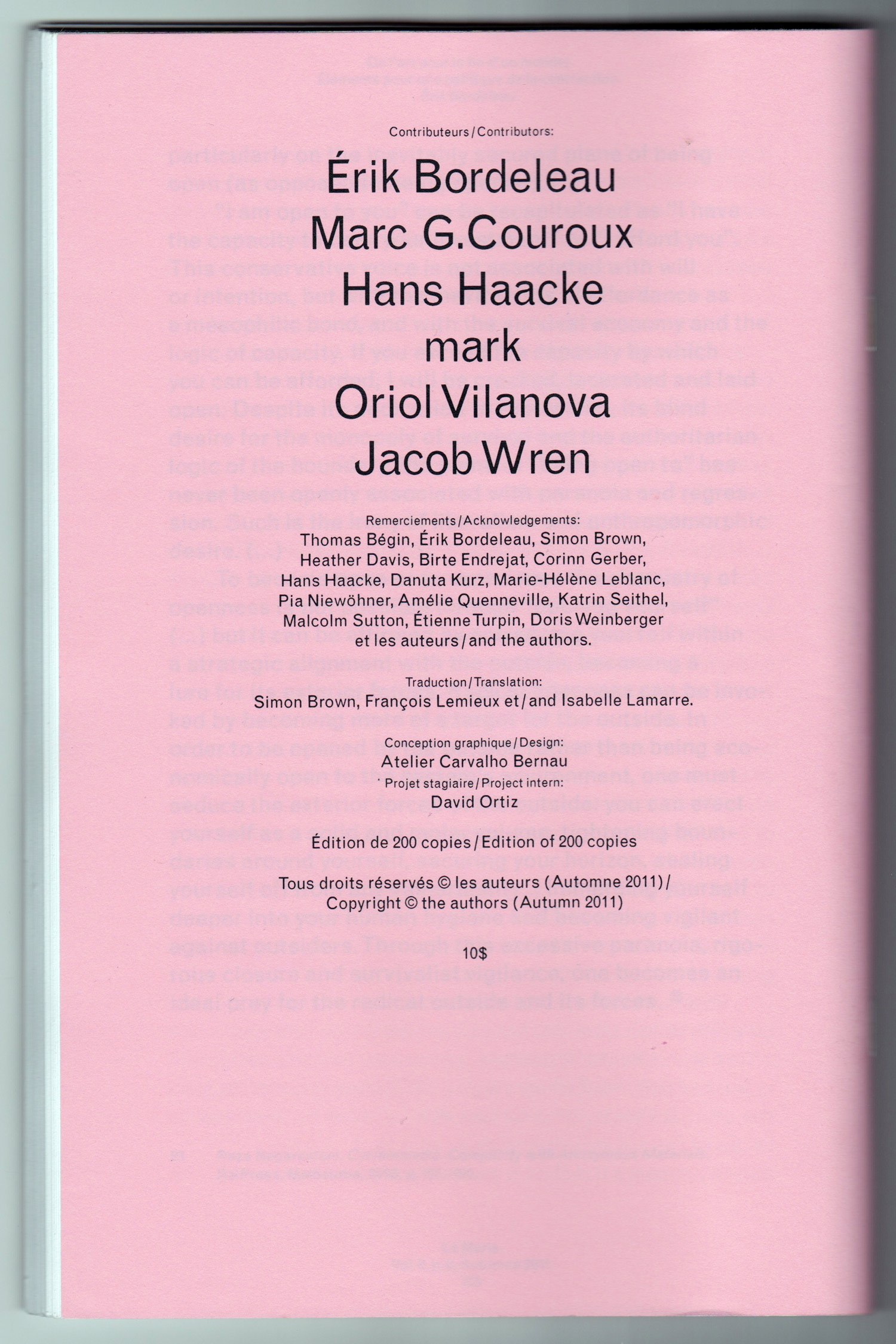„mark in conversation with François Lemieux“
La Triennale québécoise 2011, Le travail qui nous attend, Montréal
Oktober 2011, S. 00.02.42–00.02.46 (frz./engl)
„mark in conversation with François Lemieux“
Le Merle – Volume 0, number 0, Montréal,
fall 2011, S.15–23 (frz.), S.39–46 (engl.)
Der Text entstand in Kollaboration mit François Lemieux anlässlich seines Katalogbeitrags für die Quebec Triennale 2011.
Text (vollständig) / ENGLISCH
Fl ― It seems to me that your artistic practice involves considerable care, observation, and discussion, often focused in and around the circumstances within which you are invited to work. I wonder if we could talk about the practice you develop as a group?
M ― Our focus lies in pointing to the inner reality and circumstances surrounding the making of exhibitions. What remains invisible or undisclosed within that framework is something that we are familiar with as artists, exhibition makers, and sometimes as viewers. We reveal this framework as a starting point through which our artistic practice is developed, which also allows us to discuss our general attitude towards the «spectacle» of big performance shows. No need to mention that we do not necessarily make friends through our work. We are often perceived as inconvenient. In turn, collaborating with mark involves a form of risk and requires a conscious decision.
Fl ― Instead of talking about context-specificity and site-responsivity as if they were tactics, might you instead characterize these approaches as integral to your artistic practice?
M ― It has a lot to do with the pacing of how we process information. The discussions we engage in as a group allow us to slow down both the creative act, and its reception. Subsequently, the work carries a similar pace: a deceleration in consumption that holds the potential for beholders (including organizers and curators) to think about familiar circumstances from new and/or different directions. That may then lead to an acceleration in his/her own developments. We offer the spectator / beholder to break away from prior concepts and understandings towards new modes of questioning.
Fl ― Can you explain in greater detail this collective shift in speed, and its repercussions?
M ― Pragmatically, there is a big difference between working individually and working within a group. Within the group dynamic the necessity to act and to position oneself is of greater importance. During the development of a piece, our work is continuously reassessed and reflected upon by all members. The aforementioned processes of «slowing-down» describes our approach and its effects quite well. Working as a group of five means each of us brings her own professional specialization, experience, and perspective. This is why we have to work through things to crystalize an understanding of the given parameters of a project― the most time‐consuming aspect of our work. We discuss and reject ideas, essentially becoming critics of our own work. Through this process, we mutually enrich each other’s perspectives and kindle the collective enthusiasm at the same time. The resulting work, or that which the public experiences as an artwork by mark, though distilled from our individual perspectives, is perceived as the work of one single artist. Our verve becomes five-fold once it is aroused…
Fl ― We might get back to the idea of consensus later. For now, bearing in mind what we’ve already discussed, could you talk about your work for the 6. Kunstfrühling 2009 exhibition that was held in the metropolitan area of Bremen/Oldenburg?
M ― This exhibition was set up to be like an industrial fair. It was organized in two parts: first, a guest curator was invited to organize a group show; second, Bremen’s cultural institutions were asked to showcase themselves by curating their own selfcontained program.
Fl ― And mark was invited to present in the large group show, right?
M ― Yes. After receiving the Kunstfrühling curator’s invitation and discussing his offer amongst ourselves, we proposed taking over the exhibition’s ticket counter as the basis of our intervention. We first had to complete the employment application procedure. After individually submitting scaled-down versions of our resumés, we got the box office jobs. This process enabled us to earn an income for the duration of the exhibition in exchange of our services, all while conducting our artistic intervention.
Fl ― So you worked in shifts selling tickets?
M ― Yes.
Fl ― What were the reactions within the organization?
M ― For the organizers of the exhibition our position wasn’t easy to handle: the box office activity becoming part of an artist’s work within the exhibition meant that mark had first‐hand access to delicate information, such as the financial proceedings of the event. Our intervention was obviously a critical statement in opposition to the widespread convention of artist’s unpaid labour in the production of these kinds of big public events and exhibitions. The piece allowed us to explore that while at the same time fulfilling a shared desire among us to have one-on‐one contact with every single visitor of the Kunstfrühling exhibition.
Fl ― What about the other artists? How did they react to mark getting paid for their intervention?
M ― Of course, some of them were personally offended at our «profitable» idea. Some thought that we might pocket all of the money for ourselves. Which would have been a pretty ingenious, but dangerous idea…
Fl ― Could you tell me about your second intervention in the Kunstfrühling exhibition in 2011? If I remember correctly, the conditions were different. Instead of being invited for the large group show you received an invitation from a guest cultural institution. Is that right?
M ― We were invited in 2011 due to our 2009 box office intervention. One of Bremen’s institutions decided to invite mark based on the critical position we had developed for the 2009 edition. It was under these circumstances that we developed the new work.
Fl ― They wanted to somehow propose a critical project in that specific context? And you were filling this role, in a way?
M ― From our perspective, nowadays criticality is highly praised, especially in artistic discourse. It feels as though it has become a delight for curators to invite artists that present an incisive critical stance. This is something we are both sensitive to, and cautious about. In this case, the second invitation came from a curator who had little to do with the organization of 7. Kunstfrühling 2011. She invited us based on our previous work, expecting it would express somehow her own attitudes towards the «spectacle». We found ourselves having to find a balance between a certain pride because our work was being recognized and an unease in light of its potential instrumentalization by a third party. We accepted the invitation and subsequently made a work using the 2009 piece as our frame of reference. We took into account the fact that we were specifically invited to deliver critical content. “What mark was about”, or the expectation of criticality, became what needed to be addressed. Generally, the fact of not meeting expectations is manifest in our project drafts and works―not as a default attitude or principle but rather as a development within our negotiation with the work.
Fl ― What did the resulting work consist of?
M ― We made an audio guide that included 76 tracks of material dealing with the organization and the governing decisions for the exhibition that involved the spectators’ positions/ expectations/hopes, and the role of the artist. As always in our works, our objective with this work was to develop an artistic form from which we could be challenged.
Fl ― And how did it work out financially, if you don’t mind me asking?
M ― Although most art institutions rent out their audio guides, the Kunstfrühling organization didn’t allow us to ask for money.
Fl ― Because it is was piece of art?
M ― Yes, that was the main argument. But well, we wanted to ask for a symbolic amount, something like € 2 per rental. The viewer having to pay for the piece would involve a decision being made on their part. In the end, we did not charge anything and absorbed costs with the small production budget from the guest cultural institution that had invited us. This was a different situation from 2009 when artists were paid nothing at all. The Kunstfrühling organization even requested that all participating artists must pay for the group catalogue which was produced to promote the event. But our combined salaries at the ticket counter ended up being the same amount as our budget the second time around.
Fl ― If criticality is increasingly understood as symbolic currency within the visual arts, where does that leave us in terms of practice, in your view?
M ― There is no doubt that we are involved in the art market economy, whether we benefit from it or not. Therefore, we always somehow have to deal with a kind of absorption. So, we develop a practice which can also absorb the particular conditions as a framework, a system of rules, and parameters that we can work from. In Andrea Fraser’s work, for instance, you can see that in the visual arts you can try to be ahead of your time or create practices you think cannot be merged into any market strategies, but in reality these practices will eventually be fully incorporated into the art market. It must be exhausting to always feel the desire to be outside or ahead of one’s time. With our inheritance of conceptual art we don’t really see ourselves as ahead or outside, and sometimes we even forget that critical conceptual art is not as familiar and established for others as it is for us. We work from this general understanding and a broad knowledge-base.
Fl ― Would you qualify mark’s approach as somewhat speculative―organized around the challenges of what is possible, and not necessarily what is plausible?
M ― Our critical practice involves studying ways of raising awareness, not just arguing about the pros and cons. It is our need and desire to work with reduced aesthetic forms and to restrict ourselves to sensitive gestures rather than throwing grandiose images/gestures into the «space». It can be seen as old- ‐fashioned or as pointing towards the future—in any case, for us these sensitive gestures are the appropriate mode of expression. We wouldn’t exclude other techniques if they became necessary, but we can hardly imagine not working from a concrete context. It might seem naive, but while developing a work, we are quite focused on the moment and do not spend time worrying about our professional future—this might also be an advantage of our position as a collective. We feel a remarkable difference, anyway.
Fl ― What is mark’s favorite color?
M ― Are any colors better then others? So far we learned: ‘Some girls are bigger than others’ (The Smiths)


